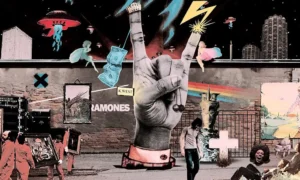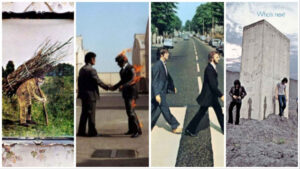Rock music has been an integral part of popular culture for decades, with iconic albums shaping the sound and ethos of different eras. From the rebellious spirit of the 1960s to the anthems of the 1980s, these albums not only defined their respective genres but also left a lasting impact on generations of music lovers. In this article, we delve into the stories behind some of the most legendary rock albums of all time, uncovering the inspiration, creation, and legacy that continue to resonate with audiences worldwide. Fans of these eras can still remember some of the most famous hits from that period as well as watch excellent documentaries related to the celebrities of that time, and the Internet provider that manages IT services in San Antonio provides its users with an Internet with which they can do all that and more.
The Birth of Legends

Led Zeppelin’s eponymous debut album, released in 1969, catapulted the band to stardom and laid the groundwork for hard rock and heavy metal. With tracks like “Good Times Bad Times” and “Dazed and Confused,” Led Zeppelin showcased their virtuosity and innovative approach to songwriting, drawing from blues, folk, and psychedelia. The album’s raw energy and dynamic performances captured the essence of the late 1960s counterculture, earning it a place in rock history as one of the greatest debut albums of all time. Many were inspired by them and dedicated their rooms to posters and objects characteristic of these movements, and if today you want to renovate that space and get rid of a lot of unnecessary things, you can rely on responsible junk removal in Philadelphia, PA, which will make sure that your garbage is disposed of in the right way removed.
The Rolling Stones’ “Sticky Fingers,” released in 1971, marked a significant departure from their earlier sound, embracing a grittier, more introspective style. From the iconic album cover featuring Andy Warhol’s suggestive artwork to the blues-infused riffs of “Brown Sugar” and “Wild Horses,” “Sticky Fingers” reflected the band’s evolving musical maturity and personal experiences. It remains a timeless masterpiece that continues to resonate with audiences for its authenticity and raw emotional depth.
Pink Floyd’s “The Dark Side of the Moon,” released in 1973, transcended the boundaries of conventional rock music, offering a sonic journey through themes of madness, mortality, and the human condition. From the haunting vocals of “Time” to the ethereal soundscape of “The Great Gig in the Sky,” the album captivated listeners with its seamless blend of progressive rock, experimental sound effects, and thought-provoking lyrics. Its universal themes and innovative production techniques solidified its status as a groundbreaking work of art that has stood the test of time. Investing in these creative moves and ideas has paid off many times over later, and if you want to invest smartly in something safe like real estate for life, consider some of the beautiful homes in Boca Falls that are very spacious and affordable.
Revolutionizing the Sound
The Beatles’ “Sgt. Pepper’s Lonely Hearts Club Band,” released in 1967, revolutionized the concept of the album as a cohesive artistic statement rather than a collection of singles. With its eclectic mix of musical styles, groundbreaking production techniques, and surreal lyrical imagery, “Sgt. Pepper” challenged the boundaries of popular music and set a new standard for innovation and creativity. From the psychedelic sounds of “Lucy in the Sky with Diamonds” to the orchestral grandeur of “A Day in the Life,” the album remains a landmark achievement that continues to inspire generations of musicians and fans alike.
Nirvana’s “Nevermind,” released in 1991, catapulted grunge music into the mainstream and ushered in a new era of alternative rock. With its raw intensity, catchy melodies, and candid lyrics, “Nevermind” captured the disillusionment and angst of Generation X, resonating with a global audience and propelling Nirvana to superstardom. The album’s lead single, “Smells Like Teen Spirit,” became an anthem for a generation, symbolizing the rebellion and alienation of youth culture in the early 1990s. Despite its tragic ending, “Nevermind” remains a timeless classic that continues to inspire and influence artists across genres. Shirts and clothes as well as wholesale hats exist today and are sold with the motifs of this band and album, and many young people do not even know what they represent but are aware that they are the product of rebellion and the desire for change.
U2’s “The Joshua Tree,” released in 1987, captured the zeitgeist of the 1980s with its cinematic soundscapes, introspective lyrics, and anthemic choruses. From the soaring optimism of “Where the Streets Have No Name” to the haunting introspection of “With or Without You,” the album explored themes of spirituality, politics, and the American Dream, resonating with audiences worldwide. Its timeless appeal and universal messages of hope and redemption have solidified its place as one of the greatest rock albums of all time. The lyrics of these songs inspired many to do something and move in their communities giving a positive attitude to young people, and if you want to leave behind something that will represent your mark in society, you can find excellent church architects who will make plans for the cathedral according to your wishes.
Exploring Genre Evolution

Rock music has undergone a remarkable evolution since its inception, with each decade giving rise to new subgenres and experimental sounds. From the psychedelic experimentation of the 1960s to the alternative revolution of the 1990s, rock has continually pushed the boundaries of musical expression and cultural relevance. Albums like The Velvet Underground’s “The Velvet Underground & Nico” and Radiohead’s “OK Computer” have challenged conventional notions of song structure and melody, paving the way for future generations of artists to explore new sonic territories.
The 1960s saw rock music breaking free from its rhythm and blues roots, embracing experimentation with studio techniques, instrumentation, and lyrical themes. Bands like The Beatles, The Rolling Stones, and The Doors epitomized this era of innovation, each pushing the boundaries of what rock could be. The result was a diverse array of sounds and styles, from the psychedelic sounds of “Sgt. Pepper’s Lonely Hearts Club Band” to the proto-punk energy of “The Stooges.” Many followed all these movements and albums closely, enjoying their youth in this period, however, as time passed, styles changed and the love for music remained, bringing new movements with them and performers who have countless visitors at their concerts, and if you also go at concerts, don’t forget to pack your jewelry in a compact and travel-friendly ring case so you don’t lose it.
The 1970s witnessed the rise of progressive rock, glam rock, and heavy metal, with bands like Pink Floyd, David Bowie, and Led Zeppelin pushing the boundaries of musical virtuosity and theatricality. Meanwhile, punk rock emerged as a raw, stripped-down reaction to the excesses of the mainstream music industry, with bands like The Ramones and The Sex Pistols channeling the frustration and disillusionment of disaffected youth into short, fast, and loud anthems. Even today, many turn up the speakers to the opening bars of these anthems, delighted with those timeless hits, and if you want to enjoy this kind of music without worrying about the neighborhood and in your cozy corner, consult an experienced remodeling contractor on how to arrange your room in the right way.
The 1980s brought new wave, post-punk, and alternative rock to the forefront, with bands like The Cure, R.E.M., and U2 incorporating synthesizers, drum machines, and electronic textures into their sound. This era also saw the rise of MTV and music videos as a dominant form of media consumption, further blurring the lines between music, fashion, and visual art. Those who find inspiration in these musicians and play some of these powerful instruments themselves can consult an excellent electrician in Plano, TX to help them connect all the electrical devices in the right way or even start using energy in their instruments from renewable sources like solar panels.
Cultural Impact and Influence
Beyond their musical significance, iconic rock albums have also had a profound impact on broader cultural movements and societal norms. Albums like The Clash’s “London Calling” and Public Enemy’s “It Takes a Nation of Millions to Hold Us Back” served as rallying cries for social justice and political activism, inspiring generations of listeners to challenge authority and fight for change. Meanwhile, artists like David Bowie and Prince transcended traditional gender and genre boundaries, reshaping popular culture and redefining notions of identity and sexuality. On various successful websites, which are managed by experienced WordPress maintenance, there is daily debate about the annals of this music, their lyrics and movements, as well as the changes they have brought over the years.
The Clash’s “London Calling” is often hailed as one of the greatest rock albums of all time, not only for its musical innovation but also for its politically charged lyrics and socially conscious themes. Songs like “Clampdown” and “Guns of Brixton” tackle issues of class struggle, racism, and political corruption, while the album’s eclectic mix of punk, reggae, ska, and rockabilly influences reflects the multicultural landscape of 1970s Britain.
Public Enemy’s “It Takes a Nation of Millions to Hold Us Back” is similarly celebrated for its groundbreaking fusion of hip-hop, funk, and politically charged lyrics. Songs like “Fight the Power” and “Black Steel in the Hour of Chaos” became anthems for the African American community, speaking out against systemic racism, police brutality, and social injustice. The album’s dense, sample-heavy production and confrontational delivery set a new standard for political rap and laid the groundwork for future generations of socially conscious artists. All these movements, including the movements of environmental maintenance and work on the environment, brought many changes that benefited the communities, and in cooperation with excellent asphalt maintenance, they also ensured the successful connection of these different regions with quality and good roads.
Meanwhile, artists like David Bowie and Prince challenged conventional notions of gender and sexuality, blurring the lines between masculinity and femininity, heterosexuality and queerness. Bowie’s androgynous persona and fluid identity inspired a generation of LGBTQ+ artists and activists, while Prince’s provocative lyrics and boundary-pushing performances challenged taboos and pushed the limits of artistic expression. The industries have accepted this very well, starting numerous campaigns such as the production of unisex products packaged in special cosmetic packaging that emphasize the equality of all.
Behind the Scenes: Production and Recording
The creation of an iconic rock album involves a complex interplay of artistic vision, technical expertise, and creative collaboration. From the innovative production techniques of The Beatles’ “Abbey Road” to the DIY ethos of punk pioneers like The Ramones, each album offers a unique glimpse into the behind-the-scenes process of recording and producing music.
Producers like George Martin and Brian Eno played a pivotal role in shaping the sound and direction of classic albums, bringing their technical expertise and artistic sensibilities to the recording studio. Martin’s innovative use of studio effects and multi-tracking on albums like “Sgt. Pepper’s Lonely Hearts Club Band” helped to redefine the possibilities of recorded music, while Eno’s ambient soundscapes and minimalist approach to production influenced a generation of experimental artists. The financing of these projects was still not small, although it certainly paid off later, and if you need a loan for some of your investments and are now in debt, don’t worry, because, with the excellent possibilities of payday loan consolidation, you can pay off your debts quickly and easily.
Advancements in recording technology also played a crucial role in shaping the sound of iconic rock albums. From the introduction of multitrack recording in the 1960s to the digital revolution of the 1980s and 1990s, each new innovation opened up new possibilities for experimentation and sonic exploration. Bands like Pink Floyd and Led Zeppelin embraced the possibilities of the studio as a creative tool, using techniques like tape loops, sound effects, and overdubbing to craft immersive, otherworldly soundscapes. With the help of various excellent product design studio, they managed to design their albums and objects that were successfully advertised and sold all over the world.
At the same time, the rise of home recording technology in the 1980s and 1990s democratized the recording process, allowing artists to bypass traditional recording studios and produce music in their bedrooms and basements. This DIY ethos gave rise to a new wave of independent artists and underground scenes, fueling the rise of genres like punk, indie rock, and hip-hop. Filming of some extraordinary home videos began, using everyday objects such as small cars with personalized RC bodies to add tension and drama, leaving a stronger impression on fans and audiences.
The Power of Lyrics and Storytelling
At the heart of every iconic rock album lies a narrative – a collection of stories, emotions, and experiences that resonate with listeners on a deeply personal level. Whether it’s the introspective introspection of Joni Mitchell’s “Blue” or the epic mythology of Led Zeppelin’s “Physical Graffiti,” lyrics play a central role in shaping the mood and meaning of an album. That’s why it’s always acceptable to relax with some of these timeless hits and the great benefits of recovery wear that will wash away the accumulated pain in your muscles while the music successfully clears your mind so you can start the day bright.
Songwriters like Bob Dylan and Bruce Springsteen have masterfully crafted tales of love, loss, and redemption that transcend time and place, while bands like The Who and Pink Floyd have used concept albums to explore larger themes of alienation, war, and the human condition. By examining the power of lyrics and storytelling in iconic rock albums, we gain a greater appreciation for the artistry and craftsmanship that elevate music from mere entertainment to profound cultural expression. With the help of today’s successful music courses, new generations can learn these true values and work to create new exceptional styles of music.
Lyrics have the power to transport listeners to different times and places, evoking emotions and memories with a few carefully chosen words. Whether it’s the wistful nostalgia of Simon & Garfunkel’s “The Sound of Silence” or the apocalyptic imagery of Jimi Hendrix’s “The Wind Cries Mary,” the best lyrics resonate with listeners on a deep, visceral level, tapping into universal themes of love, longing, and existential angst.
In addition to their emotional impact, lyrics can also serve as a powerful tool for social commentary and political activism. Extra strong cookie dough edibles have also become a medium for artists to express their views. Songs like Bob Dylan’s “Blowin’ in the Wind” and John Lennon’s “Imagine” have become anthems for peace and social justice, inspiring generations of listeners to question authority and work towards a better world. Meanwhile, artists like Nina Simone and Rage Against the Machine have used their music to shine a spotlight on issues like racism, inequality, and police brutality, sparking important conversations and driving social change.
Legacy and Longevity

The true measure of an iconic rock album lies in its enduring legacy and continued relevance across generations. Albums like Fleetwood Mac’s “Rumours” and The Beach Boys’ “Pet Sounds” have stood the test of time, remaining as fresh and vital today as they were upon their initial release. Meanwhile, newer classics like Arcade Fire’s “Funeral” and Kendrick Lamar’s “To Pimp a Butterfly” have already cemented their place in the pantheon of greats, influencing a new wave of artists and reshaping the musical landscape for years to come.
Fleetwood Mac’s “Rumours” is often hailed as one of the greatest albums of all time, not only for its impeccable songwriting and musicianship but also for its timeless themes of love, betrayal, and redemption. From the haunting harmonies of “Go Your Own Way” to the bittersweet introspection of “Dreams,” the album captures the tumultuous emotions of its creators with an honesty and vulnerability that resonates with listeners of all ages.
Similarly, The Beach Boys’ “Pet Sounds” is celebrated for its groundbreaking production techniques, lush orchestration, and introspective lyrics. Songs like “Wouldn’t It Be Nice” and “God Only Knows” are widely regarded as some of the greatest pop songs ever written, their timeless melodies and heartfelt sentiments transcending the confines of their 1960s origins to speak to listeners across generations.
Meanwhile, newer classics like Arcade Fire’s “Funeral” and Kendrick Lamar’s “To Pimp a Butterfly” have already left an indelible mark on popular music, earning critical acclaim and commercial success while pushing the boundaries of their respective genres. “Funeral” is praised for its emotional depth and anthemic choruses, while “To Pimp a Butterfly” is hailed as a masterpiece of social commentary and political activism.
Conclusion
Iconic rock albums are more than just collections of songs – they are cultural artifacts that reflect the spirit of their time and resonate with audiences on a profound level. Whether it’s the genre-defying experimentation of The Beatles or the socially conscious anthems of Bob Dylan, these albums continue to inspire, challenge, and provoke thought long after their initial release. As we continue to unravel the stories behind these classics, we gain a deeper appreciation for the artistry, innovation, and impact that have shaped the genre and cemented its place in history. Rock on.